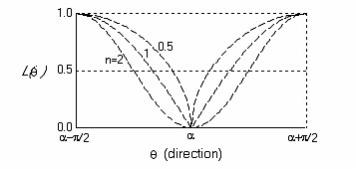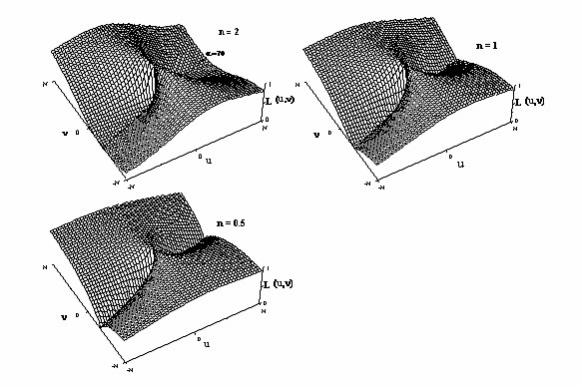Directional Cosine (DCOS)
Use the Directional Cosine option to apply a directional cosine filter.
Directional Cosine Filter dialog options
|
Cut-off azimuth |
Direction of the filter in degrees azimuth (from North CW) in space domain. It can be used to isolate or remove a predominant geological strike. |
|
The degree of the cosine function (n). By default, a degree of 2 is used to give a cosine squared function. |
|
|
|
Rejecting a direction attenuates all wavenumbers in that specified direction. Passing a direction equates to keeping only wavenumbers in that specific direction. By default, the direction is rejected. |
Application Notes
The directional cosine filter is used to remove or isolate signal in the specified azimuth direction. The rejection (or pass) notch can be narrowed or widened by setting the degree of the cosine function so that highly directional features can be isolated more narrowly (see the filter figure below). The use of a directional cosine filter instead of a straight directional pass/reject filter is recommended as it overcomes the ringing artifacts associated with the discrete Fourier transform.
Decorrugation of poorly levelled magnetic data is a common application for this filter. To eliminate signal of this nature, first pass all signal along the azimuth angle perpendicular to the flight direction. The output will contain all wavelengths in this predominant direction. Next, apply a high-pass Butterworth filter on this output to isolate the wavelength equal and shorter than 2 line spacing. You may have to adjust this cut-off . The resulting output should contain the majority of the corrugated signal in the direction normal to the flight lines. Finally, subtract this grid from the initial input grid to attenuate the line to line corrugation.
Directional cosine filter
|
|
to reject direction |
|
|
to pass direction |


Wavenumber domain variable definition
|
k |
Wavenumber domain increment, used to depict a radially symmetrical variable. |
where: np is the number of points cs is the cell size |
|
u |
X component in the wavenumber domain. | k = 2π ( i μ+j ν ) |
|
v |
Y component in the wavenumber domain. |
|
|
r |
Radial component in the wavenumber domain. |
|
|
θ |
Polar component in the wavenumber domain. |
|
Got a question? Visit the Seequent forums or Seequent support
© 2023 Seequent, The Bentley Subsurface Company
Privacy | Terms of Use

 Reject
Reject Pass
Pass